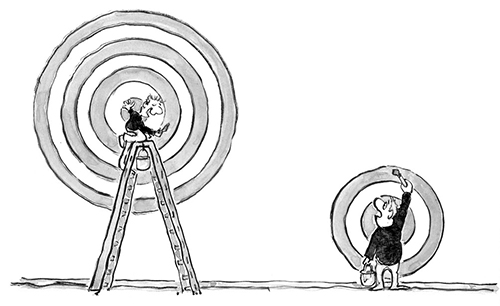Yet another
After stumbling upon the article, “Switch to e-books was ‘an unmitigated disaster,’ says school principal,” in my feed this past week, it occurred to me that there are increasingly predictable patterns surrounding stories of failed “innovation” in digital learning initiatives. Schools have been assigning computers to each child for some time now. And still, we continue to see stories like this in the media.
In short: we can do better.
The real target
But how? Unfortunately, none of these stories are terribly surprising. Many who read this article will likely slide straight into: “The HP Elite Pad? No wonder this was a disaster. That’s clearly the wrong device.” Don’t get me wrong. I wouldn’t recommend such a purchase for most classroom situations. My preferences over the past five years can likely be mined from the pages of this blog. But keep in mind: most outright failures of a digital learning initiative aren’t about the laptop/tablet you choose. I’ve noticed that time after time, most of these stories of failure in the media seem to arise from schools that set their sights upon a “digital conversion.” To me, this usually indicates a black hole of vision within the system. Making a massive systemwide purchase all in the name of trading out paper textbooks for digital textbooks is drawing your aim at the wrong target. Carefully consider this point: adopting computing devices as front-line learning tools is not the end game, it is one strategy in building a modern and responsive educational ecosystem.
It is true that a move from a dearth of access to one where every student is saddled with a laptop/iPad/Chromebook/etc. is a significant one. Because of this, it is easy to sit back and bask in the satisfaction of tackling the access issue. It is certainly a celebration worth having. Computers are everywhere on day one of a 1:1 rollout. Access is the easiest box in the plan to check off. It is true that getting to this level of access requires significant logistical, financial, and political struggles. The real festivities should happen when, and not before, the entire learning environment has changed for the better. The issue at the heart of all this is where you want to be when all of these hurdles are cleared. If you cannot envision the details of the learning ecosystem you are seeking, go back and dig into what this means for a learning institution. The last thing you want to do is try to figure this out after every child and teacher possesses a digital device in support of yesterday’s educational ecosystem. Start at the top.
Get out the telescope
Ask yourself what it is you really want for the children in your charge. Are you still comfortable with the following?
- Textbooks being the central resource for course content
- Student tasks submitted for an audience of one: the teacher
- Every child learning the same thing in time with every other child
- “Creative” experiences consisting entirely of document creation
- Online learning that consists of a checklist of independent tasks
- School as defined by what is taught as opposed to what is learned
- Measuring seat time and percentage grades as indicators of academic success
If you can say “yes” for many of the above, you might not find the logistical, financial, and political friction required by a move to 1:1 worth the trouble. If you’re still comfortable with many of these elements, you are still content with school as it has been for decades, and so often continues to be. Changing any of these characteristics takes more than a pocketbook and a five-step rollout plan. Developing educators as leaders on top of a shifting paradigm of what learning can be today is a far different task. This requires a plan with a robust framework for professional development and a built-in ability to be responsive to the needs of educators at each stage of the process.
We already know this to be true. Outstanding teachers effectively plan on two levels: 1) designing a long-term framework for learning built directly upon standards, that 2) includes a system of short-term responses to react to individual student needs based upon authentic formative assessment of learning. You read it right, a two-tiered plan involving both proaction and reaction. The best planning at any level involves a complex interplay between the two. The long-range and the short-term. The big picture as well as the detail. Education is serious business, huh?
Plug in the microscope
The same attention to proaction and reaction applies to the planning needed to move any learning organization into new territory. If you are truly no longer comfortable with the seven elements listed above, the next step is to dig into the details of your vision. Ask yourself and your team the following questions:
- What resources for learning are available today? What would an ideal mix of resources consist of? Who is responsible for vetting said resources?
- How can we best harness the power of the Internet to cultivate authentic audiences for student work and learning? What does open inquiry look like today?
- What is the ideal progression of learning for a child? Do we plan for this at the student level? Do we react to this at the student level? How do we facilitate this?
- What is an authentic learning task? What does creativity look like today? Does your definition extend beyond the realm of documents? How do you feel about digital “poster projects?” Study the TPACK & SAMR frameworks together.
- Define “blended learning.” What do you think of when you hear the term, “online course?” What should define an “online course?” Where and how does conversation fit into the description? Talk about space and time. Talk about the Carnegie Unit.
- Is a 1:1 implementation an opportunity to study standards-based grading? If you’re really daring, try considering… why grade?
- Can you sketch three scenes depicting what your ideal school should look like? What is happening in those scenes? What is not? I’m really not kidding here. Do this. Don’t just discuss it. The value is in the slow process and the conversation.
If you really commit to an open study of these questions and tasks, then you will have a far clearer picture of what you believe today. You will possess the raw mental material for the next step. The next step will be to design the framework for the future. This is the fun part; the good stuff. This is the step I cannot even attempt to deliver generic bullet points for. This is the stage that, based upon your responses, moves in a unique direction for every learning community. How do you know when your educators are on the same page? How will you know your broader community understands what you’re trying to do? Quickly get beyond the jargon. Disclaimer: There is nothing inherently magical or official about the above set of mental metrics. They are merely questions I believe lie at the heart of this work.
It all comes back to your vision for and philosophy of learning. If you continue to see school as a top-down endeavor where knowledge is first owned by the teacher and then somehow magically transmitted into the brains of students, then that will guide (no: govern) your mission of bringing modern technology into classrooms. However, if research and experience have led you to the idea that perhaps real learning happens within the mind of the learner and is influenced by many inputs (one of which is a skilled teacher)… then you’ll likely make significantly different decisions for the future.

Design the process
This morning’s stream of thought reminds me of a post I logged four years or so ago. I can actually say I still stand behind those “four pillars” after considerable experience since that time. Like I said back then, “It’s not that dark in there anymore. Trust that there are others who have proceeded down this path before you, and they have learned many important lessons.” Get the right people into the room from the start. If you fear, “we don’t know what we don’t know,” get some outside experience into the room. Represent all levels of your organization. Think big, and think little. Ask the big questions first. Then work through the details before even mentioning “the device.” Many will want to jump there. Stay strong. Design protocols that help protect the conversation. Develop a true vision. Let it guide you. Under our best progressive lens “unmitigated disasters” rarely happen.
Artwork
*”Defining targets differently” by Fritz Ahlefeldt-Laurvig on Flickr via CC *”Untitled” by Brongaeh on Flickr via CC *”Objectives” by Oliver Braubach on Flickr via CC *”Business project drawn…” by Sergey Nivens purchased from Shutterstock.


What a wonderful post. I am the chair of a digital learning committee at my school and I shared this with some of our most important stakeholders within the faculty. I am also going to link to this on my blog as well.
Thanks, Jim. Feel free to stop back in with a link to your blog when you’re ready. I’d love to see your reflections in that space.
To me, this is dead on perfect. I couldn’t agree more on nearly every point you make. I wish I could offer some insightful commentary to stretch your thinking, but I honestly think this is a perfect model for K-12 change going forward. Well done.
Appreciate the feedback, Mark. Thanks for taking the time to leave a note. By all means, if upon reflection you feel like poking back at any of these ideas, please do. Happy holidays.
Thank you for that thoughtful article, Sean. I like how you clarify the thought process for bringing schools into the 21st century. I wonder how we get these ideas into the hands of policy makers?
Thanks for joining in, Dvora. How do we get ideas & opinions into the hands of “policy makers?” I have some thoughts on that.
For one, I know exactly what you mean by “policy makers.” I don’t really know your current position, but it is easy to view some positions as “leadership” positions, and others not so much. I happen to be of the mind that every position is a leadership role if you want it to be.
If you dig back far enough, there are posts on this blog back from when I was a high school building instructional coach/biology teacher… that landed me directly in meetings with district level directors. So in that sense, how do we do it? Just exactly like we’re doing now. Get your ideas out there. Or at least, circulate the voices that fit your philosophy. I was more than surprised at the ripples than can be created by the written word in public spaces. Some of the first direct progress that resulted from this blog happened at a time when I was convinced that only my Mom, my wife, and my principal were following along. I’ve been surprised many times since.
So yes, in short: when you feel stuck, lead your way out of it. Effective leadership is almost always less like a struggle or battle. It is typically more like articulating careful and detailed opinions, listening to the thoughts, opinions and dreams of others, allowing time to think and process… and moving forward collectively from there. Sometimes that all starts with a set of words or ideas to center a discussion around.
So yeah, I don’t know if any of that helps, or even makes sense, but it is what seems to make sense to me at this time. There are no doubt many, many ways to effect change. I’ve always felt comfortable sticking to descriptions of the work I have personally done, or the stories of those I have assisted in some way. I have to feel connected directly to the work I am advocating for. Ideas without roots are mere vapors.
Just posted a reflection on your article at http://mrdardy.wordpress.com/2013/12/03/the-challenges-of-technology-in-the-classroom/ and linked to you there.
Thanks again for a thought-provoking post!
Sounds like you’re in the midst of some challenging and fun changes. That is, of course, if you like gray areas, right? 😉 I left you a few words on your blog. Thanks again for adding threads to this discussion.
A school culture from the top down has to value collaboration and teacher leaders. Unfortunately, not all schools do.
Great article….goes with one I’ll be publishing later today. I was actually looking at your 4 pillars post again as I work with an administration team tomorrow.
Funny how things we said years ago still hold true today. Great article on where our thinking really needs to be headed. Like you I see too much time spent on the device conversation and not enough time on the “then what?” conversation. I wrote an article not to long ago on the idea that devices replacing textbooks is a given….that’s the low hanging fruit. It’s the questions that you pose here that are the real conversation starters. http://www.thethinkingstick.com/connected-devices-supersede-textbooks/